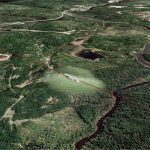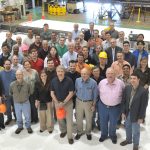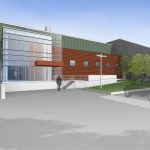Ash River, Minn. – Construction begins this month on a cutting-edge physics laboratory in northern Minnesota, supported by the American Recovery and Reinvestment Act. Congressman James Oberstar of Minnesota and Congressman Bill Foster of Illinois today (May 1) are joining officials from the U.S. Department of Energy, Fermi National Accelerator Laboratory and the University of Minnesota to break ground for NOvA, the world’s most advanced neutrino experiment.
“This project is part of a bold, visionary initiative which will have profound implications for our understanding of the structure and evolution of the universe,” Congressman Oberstar said. “The billion-year-old rock formations in Northeast Minnesota are helping researchers unlock mysteries of the origins of the universe.”
The DOE Office of Science has provided $40.1 million in Recovery Act funding for the construction project. It will provide an additional $9.9 million in Recovery Act funding to Fermilab, which manages the project, for purchasing key high-tech components for the project from U.S. companies, enabling those firms to retain and hire workers.
Community members also are gathering in nearby Orr, Minn., for a public presentation about the project and its impact on the local community.
The NOvA project will construct the NuMI Off-Axis Electron Neutrino Appearance (NOvA) detector facility, a laboratory of the University of Minnesota’s School of Physics and Astronomy, near the Ash River, about 40 miles southeast of International Falls. The lab will house a 15,000-ton particle detector that will investigate the role of subatomic particles called neutrinos in the origin of the universe.
“The NOvA project will fundamentally expand our understanding of neutrinos, but it will also help strengthen scientific partnerships between the University of Minnesota and Fermilab in my district,” Congressman Foster said. “Fermilab is where much of detector equipment is being built, and the neutrino beams also originate at Fermilab. This project represents the kind of investment that simultaneously supports basic scientific research, our national labs and our economy.”
Construction of the facility, supported under a cooperative agreement for research between the U.S. Department of Energy and the University of Minnesota, is expected to generate 60 to 80 jobs. In addition, the construction will result in procurements for concrete, steel, road-building materials and mechanical and electrical equipment from U.S. firms.
“The NOvA project is an investment in our scientific future that will help us to better understand the role that neutrinos have played in the evolution of the universe,” said Dennis Kovar, DOE Associate Director of Science for High Energy Physics. “NOvA’s groundbreaking reaffirms America’s commitment to retaining its position of leadership in accelerator-based particle physics.”
The NOvA project involves about 180 scientists and engineers from 28 institutions. The collaboration will build the neutrino detector and install it in the new laboratory. When the detector is completed, physicists will explore the mysterious behavior of neutrinos by examining pulses of neutrinos sent straight through the earth from Fermilab in Illinois to the NOvA detector facility in Minnesota. The neutrinos travel the 500 miles in less than three milliseconds.
“The planning for the NOvA Facility has been years in the making, and we’re very excited that it is becoming a reality,” said University of Minnesota physics professor Marvin Marshak, a lead faculty member on the project. “This project will provide tremendous opportunities for University of Minnesota faculty and students to work with experts from around the world on important research.”
The new laboratory expands the university’s international reputation as a leader in neutrino research. The University of Minnesota currently runs the Soudan Underground Laboratory near Tower, Minn., the only laboratory of its kind in the United States. For more information about the NOvA groundbreaking, please visit http://www.fnal.gov/nova/.
For additional information about the NOvA experiment, please see http://www-nova.fnal.gov/fermilab_nova.pdf
Fermilab is a Department of Energy Office of Science national laboratory operated under contract by the Fermi Research Alliance, LLC. The DOE Office of Science is the single largest supporter of basic research in the physical sciences in the nation and helps ensure U.S. world leadership across a broad range of scientific disciplines.
- This rendering depicts the future NOvA detector facility on the property in Ash River, Minnesota, about 40 miles southeast of International Falls. Rendering by Holabird & Root
- Members of the NOvA collaboration pose during a collaboration meeting the weekend of April 24, 2009. Photo: George Joch of Argonne National Laboratory
- Ash River near the future site of the NOvA detector facility. Photoa; William Miller, NOvA installation manager
- A rendering of the entrance to the NOvA detector facility. Physicists will use the NOvA experiment to analyze the mysterious behavior of neutrinos sent through the Earth from Fermilab in Illinois to the NOvA detector in Ash River, Minnesota. Rendering by Holabird & Root








